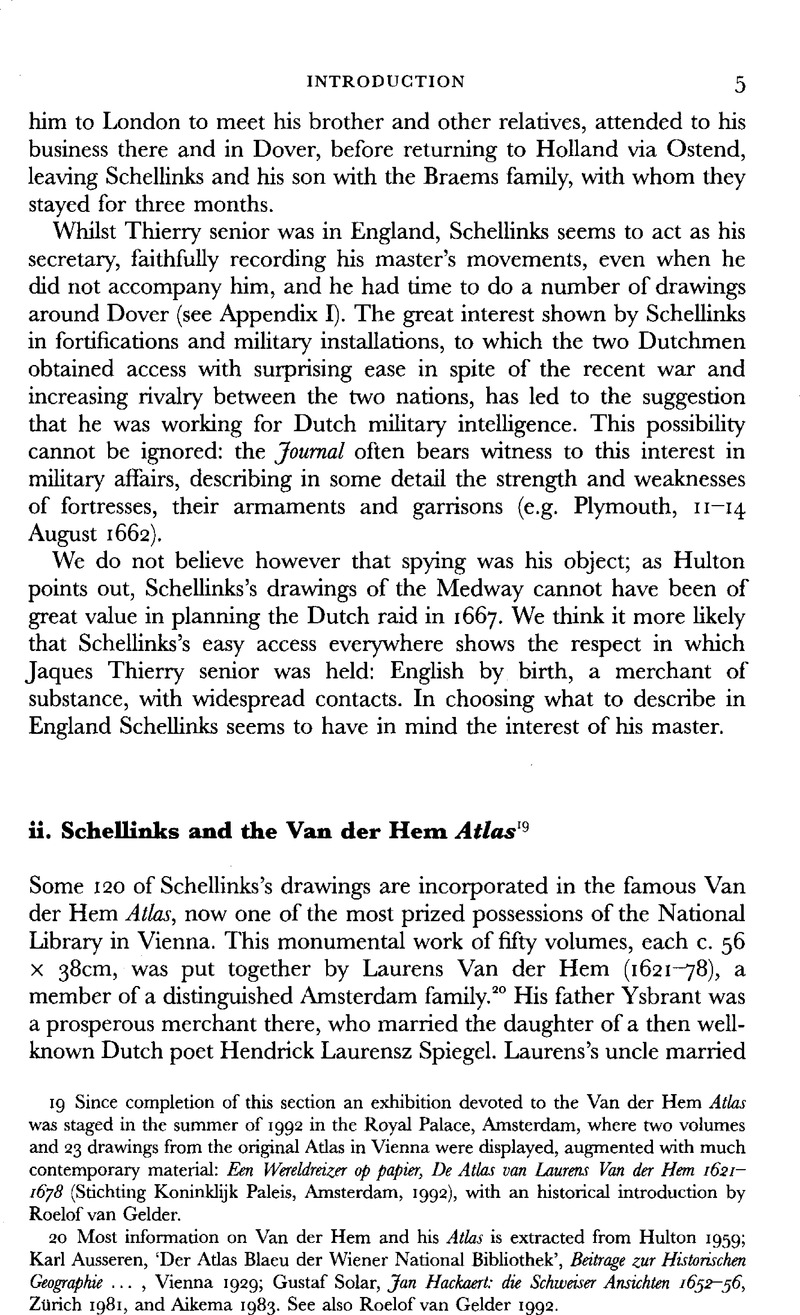No CrossRef data available.
Article contents
ii. Schellinks and the Van der Hem Atlas19
Published online by Cambridge University Press: 13 October 2009
Abstract

- Type
- Introduction
- Information
- Copyright
- Copyright © Royal Historical Society 1993
References
20 Most information on Van der Hem and his Atlas is extracted from Hulton 1959; Ausseren, Karl, ‘Der Atlas Blaeu der Wiener National Bibliothek’, Beitrage zur Historischen Geographie …, Vienna 1929Google Scholar; Solar, Gustaf, Jan Hackaert: die Schweiser Ansichten 1652–56, Zürich 1981Google Scholar, and Aikema 1983. See also Roelof van Gelder 1992.
21 Ausseren, , pp. 5–6.Google Scholar
22 van Gelder, , p. 10.Google Scholar
23 Aikema states that in 1676 he was assessed for tax on a wealth of 211,000 Guilders (c. £21,000), a large sum at the time: Aikema, 1983, p. 16.
24 Hoogewerff, G J., De Twee Reizen van Cosimo de' Medici', door … de Nederlandm 1663–1669, in Historisch Genootschap Utrecht, Amsterdam 1919, 3, 41.Google Scholar
25 Patin, Charles, Relations historique et curieuse de voyages en Allemagne, Angleterre … etc., Rouen 1676, p. 161.Google Scholar
26 This is born out by Roelof van Gelder (note 19 above), who established that binding did not commence until the early 1670s (it was not completed at Van der Hem's death in 1678). Material dated up to 1677 was incorporated in the Atlas: Roelof van Gelder 1992, p.16.
27 Bibliotheca Hemmiana (Sale catalogue, Amsterdam 1684)Google Scholar, British Library microfilm B 619/107. The printed copy in the British Library is the only one known to have survived.
28 Amsterdam became the major mapmaking centre of Europe in the seventeenth century; Jodocus Hondius took over Mercator's Antwerp business and with it his unique plates, and settled in Amsterdam. Hondius was succeeded by his son Henry, and he in turn by Jan Jansson, who married into the Hondius family. In 1671, when Patin was in Amsterdam, Jansson had died, but the business continued to publish some maps. Patin's comment on navigational maps indicates that it was Blaeu's business he saw. Blaeu's printing works were destroyed by fire in 1672. See Tooley, R.V., Maps and Mapmakers, (1978)Google Scholar. For Blaeu and his family see Koeman, Cornelis, Joan Blaeu and his Grand Atlas, London/Amsterdam 1970.Google Scholar
29 In 1847 twenty-eight large drawings, mostly by Schellinks, were removed from their original places and kept in a separate box in the director's room (Ausseren, 37).
30 Ausseren, , 10, 11.Google Scholar
31 Ausseren, , 12.Google Scholar
32 The auction catalogue (see note 27 above) of Van der Hem's library includes 24 pages ‘illuminatarum’ headed ‘A large quantity of unusual and rare illustrative material, bound books of drawings of the best Italian, French, German, and Dutch artists … collected with great effort and expense … illuminated most beautifully by D.J. van Santen …’ Clearly when Van der Hem died in 1678, there was still a large amount of material similar to that incorporated in the Atlas, which was probably intended for that purpose. We did not find any drawings by Schellinks in this catalogue, which seems to indicate that Van der Hem used all the drawings he bought, in the atlas.
33 von Uffenbach, Zacharias Conrad, Merkwürdige Reisen durch Nudersachsen, Holland und Engelland, Ulm/Hemmingen 1753/1756.Google Scholar
34 See note 32.
35 Ausseren, , p. 9Google Scholar; J. Van Gelder suggests 20,000 guilders, but draws attention in his note 30 to the controversy over the price paid.
36 Moetjens, Adrian, Atlas Geographique et Hydrographique de Laurens Van der Hem, The Hague 1730.Google Scholar
37 Ausseren, p. 9Google Scholar. Prince Eugene of Savoy (1663–1736), after a successful career as commander of the armies of three successive Austrian emperors, became a great collector and amassed a fine library.




